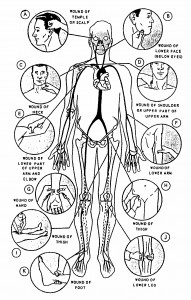If an artery is damaged, you can use your finger, thumb, hand, or knee to apply pressure to the artery at a pressure point above the wound.
The pressure compresses the artery against the bone, thus reducing blood flow or stopping the blood flow entirely. Since it is difficult to maintain sufficient pressure on the artery and more than one blood vessel is usually involved in the injury, the pressure point method is used only until a pressure dressing can be applied. Figure 2-10 shows the location of common pressure points. A pulse can always be felt at a pressure point.
a. To control arterial bleeding of the upper part of the upper arm, apply pressure to the subclavian artery (figure 2-10 D).
b. To control arterial bleeding of the lower part of the upper arm or at the elbow, apply pressure to the brachial artery (figure 2-10 E).
c. To control arterial bleeding of the forearm, apply pressure to the lower part of the brachial artery (figure 2-10 F) or to the ulnar or radial artery.
d. To control arterial bleeding of the wrist or hand, apply pressure to the ulnar or radial artery (figure 2-10 G).
e. To control arterial bleeding of the thigh, apply pressure to the femoral artery (figures 2-10 H and I).
f. To control arterial bleeding of the lower leg, apply pressure to the popliteal artery (figure 2-10 J).
g. To control arterial bleeding of the foot, apply pressure to the anterior or posterior tibial artery (figure 2-10 K).

